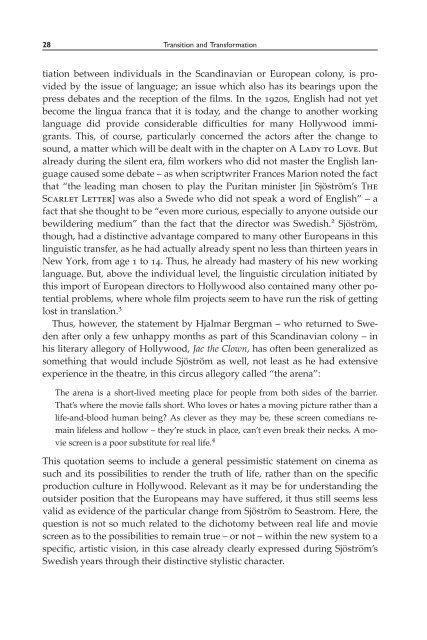FILM FILM - University of Macau Library
FILM FILM - University of Macau Library
FILM FILM - University of Macau Library
You also want an ePaper? Increase the reach of your titles
YUMPU automatically turns print PDFs into web optimized ePapers that Google loves.
28 Transition and Transformation<br />
tiation between individuals in the Scandinavian or European colony, is provided<br />
by the issue <strong>of</strong> language; an issue which also has its bearings upon the<br />
press debates and the reception <strong>of</strong> the films. In the 1920s, English had not yet<br />
become the lingua franca that it is today, and the change to another working<br />
language did provide considerable difficulties for many Hollywood immigrants.<br />
This, <strong>of</strong> course, particularly concerned the actors after the change to<br />
sound, a matter which will be dealt with in the chapter on A Lady to Love. But<br />
already during the silent era, film workers who did not master the English language<br />
caused some debate – as when scriptwriter Frances Marion noted the fact<br />
that “the leading man chosen to play the Puritan minister [in Sjöström’s The<br />
Scarlet Letter] was also a Swede who did not speak a word <strong>of</strong> English” –a<br />
fact that she thought to be “even more curious, especially to anyone outside our<br />
bewildering medium” than the fact that the director was Swedish. 2 Sjöström,<br />
though, had a distinctive advantage compared to many other Europeans in this<br />
linguistic transfer, as he had actually already spent no less than thirteen years in<br />
New York, from age 1 to 14. Thus, he already had mastery <strong>of</strong> his new working<br />
language. But, above the individual level, the linguistic circulation initiated by<br />
this import <strong>of</strong> European directors to Hollywood also contained many other potential<br />
problems, where whole film projects seem to have run the risk <strong>of</strong> getting<br />
lost in translation. 3<br />
Thus, however, the statement by Hjalmar Bergman – who returned to Sweden<br />
after only a few unhappy months as part <strong>of</strong> this Scandinavian colony – in<br />
his literary allegory <strong>of</strong> Hollywood, Jac the Clown, has <strong>of</strong>ten been generalized as<br />
something that would include Sjöström as well, not least as he had extensive<br />
experience in the theatre, in this circus allegory called “the arena”:<br />
The arena is a short-lived meeting place for people from both sides <strong>of</strong> the barrier.<br />
That’s where the movie falls short. Who loves or hates a moving picture rather than a<br />
life-and-blood human being? As clever as they may be, these screen comedians remain<br />
lifeless and hollow – they’re stuck in place, can’t even break their necks. A movie<br />
screen is a poor substitute for real life. 4<br />
This quotation seems to include a general pessimistic statement on cinema as<br />
such and its possibilities to render the truth <strong>of</strong> life, rather than on the specific<br />
production culture in Hollywood. Relevant as it may be for understanding the<br />
outsider position that the Europeans may have suffered, it thus still seems less<br />
valid as evidence <strong>of</strong> the particular change from Sjöström to Seastrom. Here, the<br />
question is not so much related to the dichotomy between real life and movie<br />
screen as to the possibilities to remain true – or not – within the new system to a<br />
specific, artistic vision, in this case already clearly expressed during Sjöström’s<br />
Swedish years through their distinctive stylistic character.

















